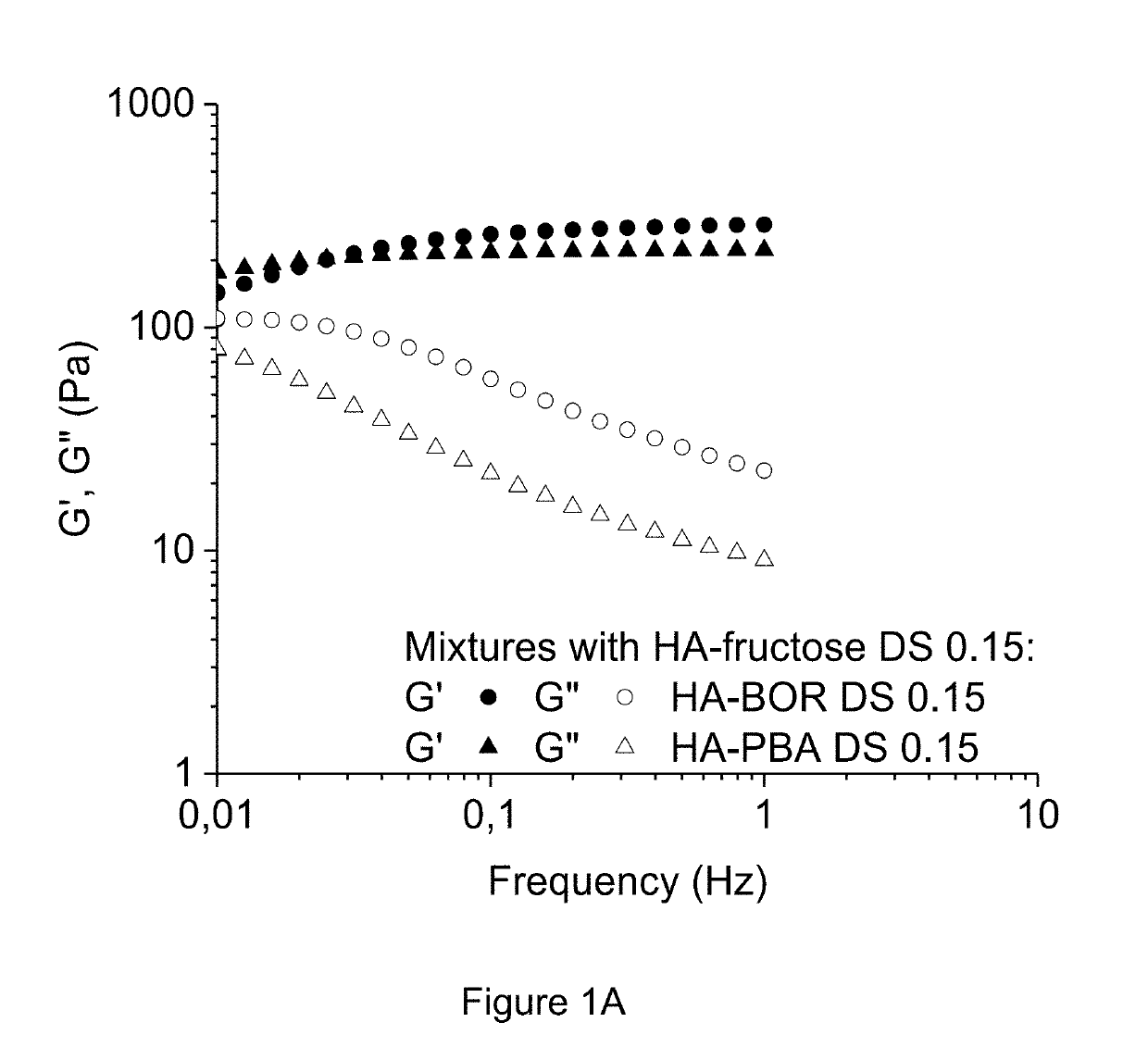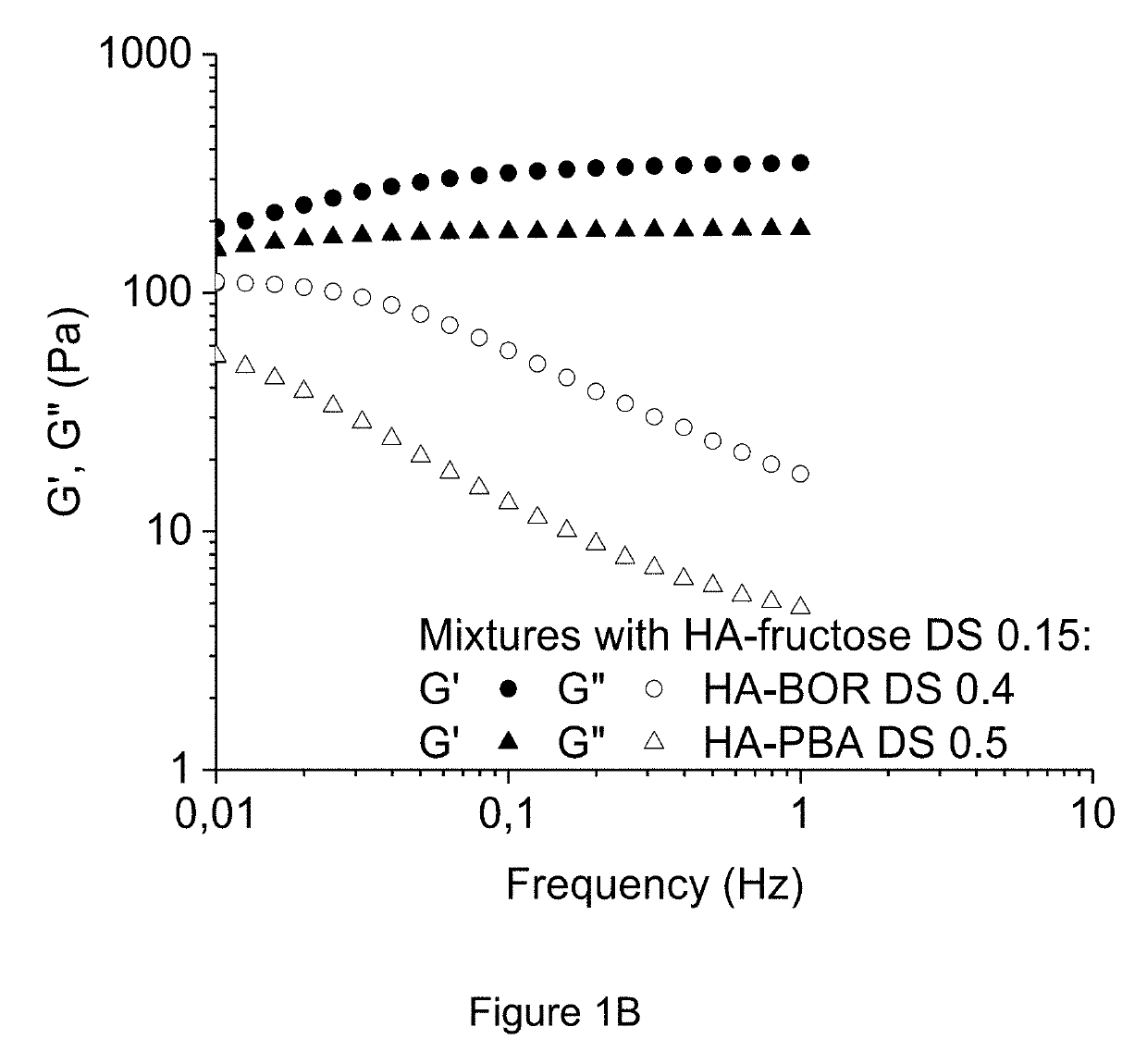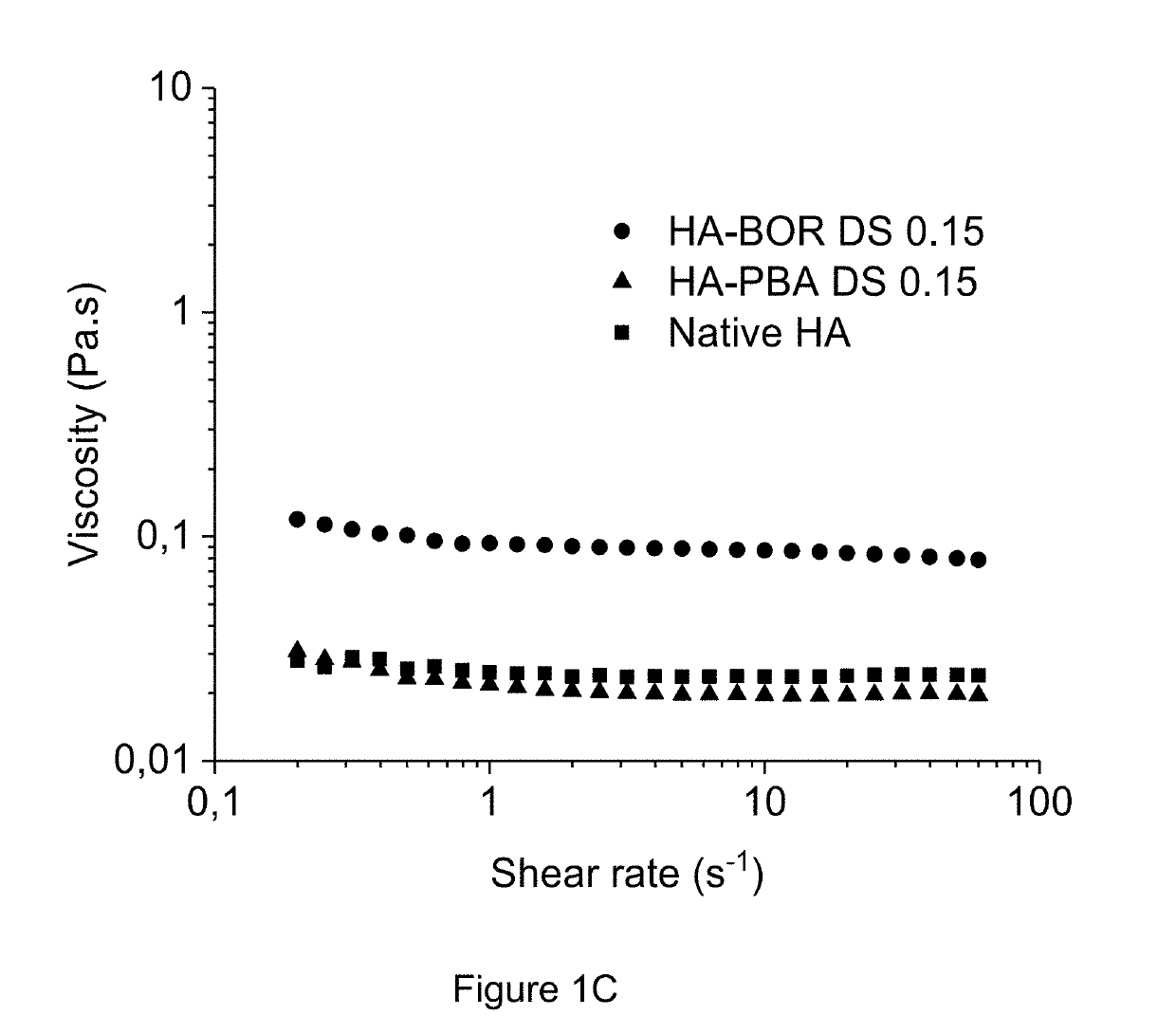Method of crosslinking glycosaminoglycans
a glycosaminoglycan and glycosaminoglycan technology, applied in the field of hydrogels, can solve the problems of difficult hydrogel injection and affect the liquid retention capacity of hyaluronic acid molecules, and achieve the effect of simple structure and less chemical modification
- Summary
- Abstract
- Description
- Claims
- Application Information
AI Technical Summary
Benefits of technology
Problems solved by technology
Method used
Image
Examples
example 1
of HA-BOR
[0181]
[0182]The amine-acid coupling agent 4-(4,6-dimethoxy-1,3,5-triazin-2-yl)-4-methylmorpholinium chloride (DMTMM) was dissolved in 1 mL of water and was added to a solution of native HA in a mixture of water / DMF (3 / 2, v / v). A concentration of HA in the reaction medium of 3 g / L was used for HA samples of 75 and 100 kg / mol, whereas 2 g / L was used for HA with 600 kg / mol. Then, 5-amino-2-hydroxymethylphenylboronic acid hydrochloride (1-hydroxy-3H-2,1-benzoxaborol-amine, ABOR) solubilized in 1 mL of water was added to the reaction medium. The pH was adjusted to 6.5 using 0.5 M HCl or NaOH and the reaction was kept under stirring at room temperature for 24 h. The product was purified by diafiltration with ultrapure water and was recovered by freeze-drying. The degree of substitution (DS) of HA-BOR was determined by 1H NMR (DSNMR), and were also estimated from the reaction kinetics performed using 2,4,6-Trinitrobenzene Sulfonic Acid (DSTNBS). This method consisted in quantifyin...
example 2
of HA-PBA (Comparative Example)
[0184]
[0185]Grafting of phenylboronic acid was done according to Example 1, but using 3-aminophenylboronic acid hemisulfate salt (APBA) instead of 5-amino-2-hydroxymethylphenylboronic acid hydrochloride (ABOR). The degree of substitution (DS) of HA-PBA was determined by 1H NMR (DSNMR), and were also estimated from the reaction kinetics performed using 2,4,6-Trinitrobenzene Sulfonic Acid (DSTNBS). This method consisted in quantifying the free primary amines in the reaction medium as a function of time. Table 1 summarizes the DMTMM / HA and PBA / HA molar ratios used for the syntheses with different Mw HA, as well as the DS and the yields of HA-PBA conjugates.
[0186]HA-PBA: 1H NMR (400 MHz, D2O) δH (ppm) 4.55 (H-1 from N-acetylglucosamine unit), 4.25 (H-1 from glucuronic acid), 3.9-3.1 (H-2, H-3, H-4, H-5, H-6 protons of HA), 2.08 (CH3—CO from HA), 7.93 (s, 1H, NH—C—CH—C—B from Ph), 7.7 (m, 2H, C—CH—CH—CH—C—B from Ph), 7.55 (m, 1H, C—CH—CH—CH—C—B from Ph).
TAB...
example 3
of Pentenoate-Modified HA
[0187]
[0188]HA (1 g, 2.5 mmol, Mw=100 kg / mol) was dissolved in ultrapure water (50 mL) under continuos stirring overnight at 4° C. DMF (33 mL) was then added dropwise in order to have a water / DMF ratio of (3 / 2, v / v). 4-pentenoic anhydride (0.454 g, 2.5 mmol) was added while maintaining the pH between 8 and 9 by adding 1 M NaOH for at least 4 h. The reaction was kept at 4° C. under stirring for one night. The product was purified by diafiltration with ultrapure water and was recovered by freeze-drying. The degree of substitution (DS) of HA-pentenoate was found to be 0.18±0.01 by 1H NMR. A yield of 49% was calculated considering its DS.
[0189]1H NMR (400 MHz, D2O) δH (ppm) 4.71 (H-1 from N-acetylglucosamine unit), 4.53 (H-1 from glucuronic acid), 4.13-3.2 (H-2, H-3, H-4, H-5, H-6 protons of HA), 2.1 (CH3—CO from HA), 6.0 (m, 1H, CH═CH2), 5.18 (m, 2H, CH═CH2), 2.62 (m, 2H, CH2—C═O), 2.45 (m, 2H, OCCH2—CH2).
PUM
| Property | Measurement | Unit |
|---|---|---|
| Fraction | aaaaa | aaaaa |
| Fraction | aaaaa | aaaaa |
| Fraction | aaaaa | aaaaa |
Abstract
Description
Claims
Application Information
 Login to View More
Login to View More - R&D
- Intellectual Property
- Life Sciences
- Materials
- Tech Scout
- Unparalleled Data Quality
- Higher Quality Content
- 60% Fewer Hallucinations
Browse by: Latest US Patents, China's latest patents, Technical Efficacy Thesaurus, Application Domain, Technology Topic, Popular Technical Reports.
© 2025 PatSnap. All rights reserved.Legal|Privacy policy|Modern Slavery Act Transparency Statement|Sitemap|About US| Contact US: help@patsnap.com



